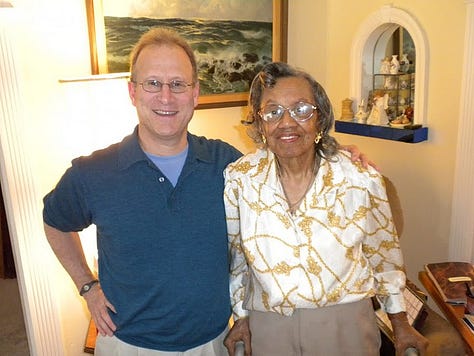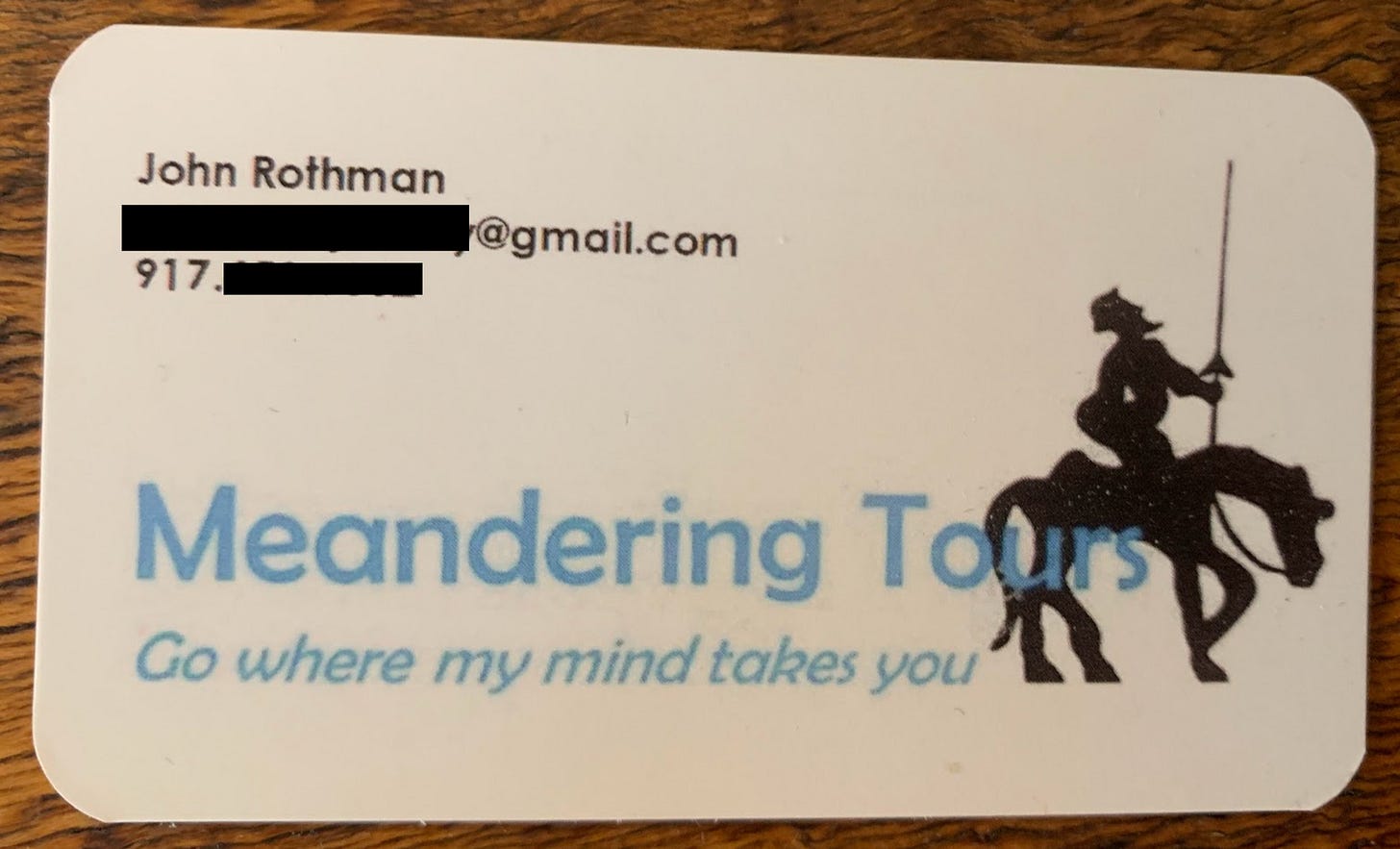5) Class Struggle
According to an adage attributed to W.E.B. Du Bois, “Children learn more from what you are than what you teach.” In other words, serving as a role model, not just a subject matter instructor, is the essence of truly meaningful teaching.
Indeed, some of us remember “the teacher who changed my life.” Or "the teacher who left a lasting impression." I was fortunate enough to have one: Charlotte Watkins, my 4th Grade and 6th Grade teacher at Mt. Washington Elementary School (PS 221) in Baltimore.
Although I can’t explain exactly why, Mrs. Watkins and I had a strong connection, so much so that I kept in touch with her over the years, not just at elementary school reunions, but also by phone, mail, and in person, until her death in 2015 at the age of 95.
Below left is a picture of Mrs. Watkins circa 1965-66, when I was in 6th Grade. The middle picture is of the two of us at her home in 2011, when she was 91. At right, is a picture of me, during that same visit, showing Mrs. Watkins my actual science project report she had assigned 40 years earlier. (I know what you’re thinking, particularly those of you who read last week’s post about my 47-page family vacation activities PowerPoint.)



Why am I writing about her? It’s because I’m concerned about the potential harm to our children caused by artificial intelligence, notwithstanding its extraordinary advantages. The advances in AI reasoning power1 are now measured in months, not years. The technology is influencing every aspect of our lives — from research and manufacturing to medicine and, yes, teaching. AI tutoring is ubiquitous, and AI teachers are going to the head of the class.2
Rick R offered this comment about a piece I wrote a few weeks ago regarding therabots, AI chatbots that provide mental health counseling:
Part of me thinks this is sad in the sense that depression is so often accompanied by loneliness (or caused by loneliness), so the idea that communication with a bot is a solution is a sad irony.
A similar concern, I think, should be considered in the case of teaching: How do you achieve the benefits of AI while preserving the role of teachers as, well, role models.
A recent conversation between Ezra Klein, the New York Times columnist and podcast host, and Jonathan Haidt, author of The Anxious Generation: How the Great Rewiring of Childhood Is Causing an Epidemic of Mental Illness, is illuminating.
They do not propose the elimination of AI in teaching but rather an appreciation that, as with smartphones, we must take steps to guard against disastrous outcomes. A quick read of some excerpts from their discussion will illustrate the basis of their concern and the importance of maintaining an appropriate human-technology balance in the classroom.
Haidt: . . . This is really our last year before A.I. has a big impact on life. . . . The internet, in a sense, gave us omniscience. But now A.I. agents are going to give us omnipotence. And that would be horrible for children.
Klein: . . . If you asked me whether I think that by the time my 3- and 6-year-olds are in middle school, we will have figured out the smartphones and social media in schools — I think we will. [Sighs.] But A.I.
I actually think about relationships the most. I’ve said this many times before: I’m a believer in transformational artificial intelligence. . . . I think A.I. is going to be more evident in its upheaval of relationships. . . .
And I think the friction of relationships between human beings is really important. As a person, it’s good for me that my wife does not adapt herself into whatever I want her to say. It is part of being a healthy human being that other people exist with friction to you. . . .
Haidt: The way we adapt is by preventing kids from having these friendships. . . . So I think we have to stop. . . . We need to realize kids have to go through a childhood in the real world with other kids within a moral universe where they experience the consequences of their own actions. And they have to learn how to deal with real people who are frustrating [emphasis added].
And if we give them A.I. companions that they can order around, that will always flatter them, we are creating people who no one will want to employ or marry. . . .
Klein: . . . It’s not that this technology will have no good adaptations. . . . now there’s somebody for [kids] to talk to. For kids whose parents work multiple jobs. Neurodivergent kids. And a lot of it will be good for some kids. But the more adoption there is and the more these companies are already in the door and competing with each other for your kids’ attention, the more the darker side of A.I. will begin to flower [emphasis added].
Haidt: . . . . So social media is so entangled, it’s very hard to rip it out. It’s going to be very hard to get it out of our kids’ childhood, but that’s what we’re working on. A.I. is not yet entangled. A.I. is just coming in. And in two or three years it will be entangled. . . . There clearly will be, and there already are, amazing uses for A.I. I’m finding that Claude and ChatGPT are just really helpful adjuncts to research. So I love A.I. as an adult. But we have to understand: Children are not adults. And given the track record so far, we have to assume that these A.I. companions will be very bad for our children [emphasis added].
I’m not a Luddite. I want our children to reap the benefits of AI in the classroom, but as an adjunct to teachers, not a replacement. I want them to have their own Mrs. Watkins. “Character is who you are when no one is looking,” she used to say to the class. I took her advice to heart, along with other life lessons she shared, accompanied by (and I can still sense this) an occasional pat on the back.
4) How the Tour Began
I’ll admit the name of this Substack is not very inventive, but it has, for me, an important origin. One of my brother-in-laws (or is it “brothers-in-law,” as in “attorneys general?”) is John Rothman, a lifelong actor. You would know him from many movies, TV shows, and plays — from Ghostbusters and Stardust Memories, back in the day, to more recent roles in Law & Order and One Mississippi.
Spending time with Johnny is a whirlwind, both mental and physical. Conversations can zigzag from politics to vinyl albums, from post-modern architecture to his grandchildren, often without notice that the subject is about to change.
When we head out together in New York City for a specific destination — say, a museum or lunch — let’s just say, it can take a while, because Johnny tends to wander in transit as well. A normally-15-minute walk can turn into an hour of detours, full of architectural observations (“Look at the frieze on that building.”), historical facts (“Eugene O’Neill used to live there.”), and random remarks (“That’s F. Murray Abraham’s apartment.”)
It’s always fascinating to be with Johnny, although sometimes a little nerve-racking, if you need to be . . . somewhere.
It occurred to me one day that Johnny would make an excellent New York City tour guide, so I came up with “Meandering Tours” as a fake company name and had a business card made for him, including a silhouette of the idealistic Don Quixote — actually 100 cards, the minimum order. The tagline was, “Go where my mind takes you.” (Regular readers will recognize a concerning habit involving wallet cards.) Johnny never landed — or even looked for — any tour business, but the cards adorn a few refrigerators around the country.
My joke led to the personal reflection that I am virtually the exact opposite of my dear brother-in-law. I’m a linear thinker, who follows rules and always looks for the straightest path from Point A to Point B. Although I like to play for laughs and enjoy a good time, my life was quite structured before I retired a few years ago. While Johnny was exploring the life of the mind, I was composing PowerPoint decks.
As part of my effort in retirement to get off the straight and narrow and follow in Johnny’s footsteps, I composed a song — uhm, cleverly titled "Meandering Tour — that can be found at these links on Spotify, Apple Music, and YouTube. Full disclosure: Each time you play it, I will earn $0.0003869 in royalties.
You’ll notice that the song leaves absolutely nothing to the imagination; the lyrics are about as literal as a “creative” work can be. I’ve released another song3 and have a few others in the works, but, try as I might, I can’t conjure a single simile or metaphor.
So, now I’m trying a different path in pursuit of creativity — namely, this Substack with an utterly unoriginal, copycat title. Thanks for joining me.
3) Curiouser and Curiouser
Are you sitting down? Perhaps in an Eames Chair, either a genuine or a knock-off? If so, I’m curious if you’ve ever heard of the Eames Institute of Infinite Curiosity in Richmond, CA? Its mission: to build on the legacy of Charles and Ray Eames, the industrial designers, who pioneered some of the most iconic office and domestic furniture of the mid-20th century. “Who would say that pleasure is not useful?” Charles asked in a 1972 interview.
The Institute recently unveiled “The Curious 100,” a list of “courageous leaders and creative minds across the United States who are harnessing the transformative power of curiosity to solve today’s most pressing problems.”
“The Curious 100” were selected by a team that included Llisa Demetrios, the chief curator of the Institute and a granddaughter of Charles and Ray Eames. Her bio in the FAQs says she has “dedicated her life and career to preserving and sharing the Eameses’ timeless philosophy of design, curiosity, and innovation with the world.” This quotation is not particularly illuminating, but it contains an excellent example, often doubted by certain friends, of the correct form of the plural possessive when a proper noun ends in the letter “s” preceded by a vowel.
Among the creative leaders selected by the Institute are Mick Ebeling, founder of Not Impossible Labs, three of whose inventions have been recognized as TIME’s Best Inventions; Dr. Ayana Elizabeth Johnson, a marine biologist and co-founder of the nonprofit Urban Ocean Lab, a think tank for the future of coastal cities; and Mae-ling Lokko, a faculty member at the Yale School of Architecture, who specializes in the development of non-toxic, bio-based materials that promote environmental health.
Despite my innate curiosity and my relevant Substack bio, I did not make the cut.
2) Sidetracks
Building of the Week: Recently opened in Helsinki, Finland, Meander Housing consists of 115 apartments and is “like the winding path of a river,” according to a description by the architectural firm that designed it. “All units open onto the landscape through high windows and private balconies with views to the Baltic Sea horizon or Hesperianpuisto Park. At night, the building glows like an ice sculpture.” By the way, Finland ranks #1 in The Economist’s 2025 “World Happiness Report,” Denmark second. Greenland is not ranked separately.
Nature, Nurture, Neurons: In an interview with The New York Times about her new book, The Ideological Brain: The Radical Science of Flexible Thinking, the neuroscientist Leor Zmigrod, says, “[T]he size of our amygdala — the almond-shaped structure that governs the processing of emotions, especially negatively tinged emotions such as fear, anger, disgust, danger and threat — is linked to whether we hold more conservative ideologies that justify traditions and the status quo.” Which comes first? Zmigrod noodles on the classic nature vs. nurture issue:
[W]hy is the amygdala larger in conservatives? Do people with a larger amygdala gravitate toward more conservative ideologies because their amygdala is already structured in a way that is more receptive to the negative emotions that conservatism elicits? Or can immersion in a certain ideology alter our emotional biochemistry in a way that leads to structural brain changes? The ambiguity around these results reflects a chicken-and-egg problem: Do our brains determine our politics, or can ideologies change our brains?4
Principle of the Week: “A lie can travel halfway around the world before the truth can get its boots on” is a quotation variously, and apparently wrongly,5 attributed to Winston Churchill, Mark Twain, and Oscar Wilde, among others. Variations actually date back to the early 1700s. A modern-day version of this adage, known as “Brandolini's Law” or the “Bullshit Asymmetry Principle,” was coined a decade ago by Italian programmer Alberto Brandolini to compare “the considerable effort of debunking misinformation to the relative ease of creating it in the first place.” The law states: “The amount of energy needed to refute bullshit is an order of magnitude bigger than that needed to produce it.” Check out the examples and footnotes on this subject in Wikipedia.
1) Get Chai
It’s Passover, the holiday when Jews commemorate the Israelites’ exodus from bondage in ancient Egypt and when my wise son asks the same thing he does every Jewish holiday: “Is this a sad one or a happy one?”
After the Seder dinner, desserts such as macaroons, sponge cake, and Chocolate Toffee Matzo Crack are served. And, for reasons never explained to me, jellied fruit candies, like these:
They’re too sweet for my taste; one (always a red) is all I can eat. But now, a company called Tokin’ Jew has come along to spice things up, with THC gummies called Tokin’ Chews that are certified as kosher for Passover.
“These Kosher-for-Passover Edibles Are So Much Better Than Fruit Jelly Slices,” proclaims a headline in a recent article in The Nosher. The company’s website contains a digitized version of the kosher certification.
Some of the product names are good (e.g., Guava Nagila), but I think the company missed better marketing opportunities, such as Bitter Herb, Thai Shtick, High Holidaze, In-Haggadah-Da-Vida, and Duderonomy.
I look forward to your own product suggestions in the comments section. May you have a happy Passover and Easter and enjoy a peaceful and productive spring.
See, e.g., “The 2025 AI Index Report” and “12 Graphs That Explain the State of AI in 2025.”
The song, called Edge and a Sway, is about Wentzle Ruml IV, an original member of the legendary L.A.-based Zephyr skateboard team known as the Dogtown Z-Boys. Their surf-like style revolutionized skateboarding in the mid-1970s and ushered in the era of extreme sports. This trailer, from a 2001 documentary, will give you a sense of who they were and what they accomplished. I met Wentzle in the summer of 2020 when he was shingling a cottage on the edge of a high ocean dune on Cape Cod, MA. He made an impression and inspired this song.
I started to do a little research on the amygdala, which was not the subject of my 6th Grade science project. I discovered that it has a right hemisphere (“more active in response to negative stimuli and aversive emotions like fear”) and a left hemisphere (“connected to the body's reward system, [capable of processing] both positive and negative emotions, [and] potentially playing a role in social behavior and emotional regulation”). I suspect there’s a very clever right-left political joke here, but I lack the scientific degrees to pull it out of a hat. Paging Amy Farah Fowler, PhD.
See, e.g., Quote Origin and Interesting Literature.










"And if we give them A.I. companions that they can order around, that will always flatter them, we are creating people who no one will want to employ or marry. . . . "
But an excellent Presidential cabinet member.
My current research involves telling the following joke to Liberals (LIB) and Conservatives (CON): A horse walks into a bar; the bartender says "why the long face". The horse replies "My job at NIH was eliminated." CON participants when encountering this joke displayed a greater activation of the mesolimbic dopaminergic reward system, including the amygdala, midbrain, and nucleus accumbens than LIB participants. This suggests a more pleasurable response to someone losing employment but perhaps also a conviction that horses should not be leading scientific research projects. More study is needed.